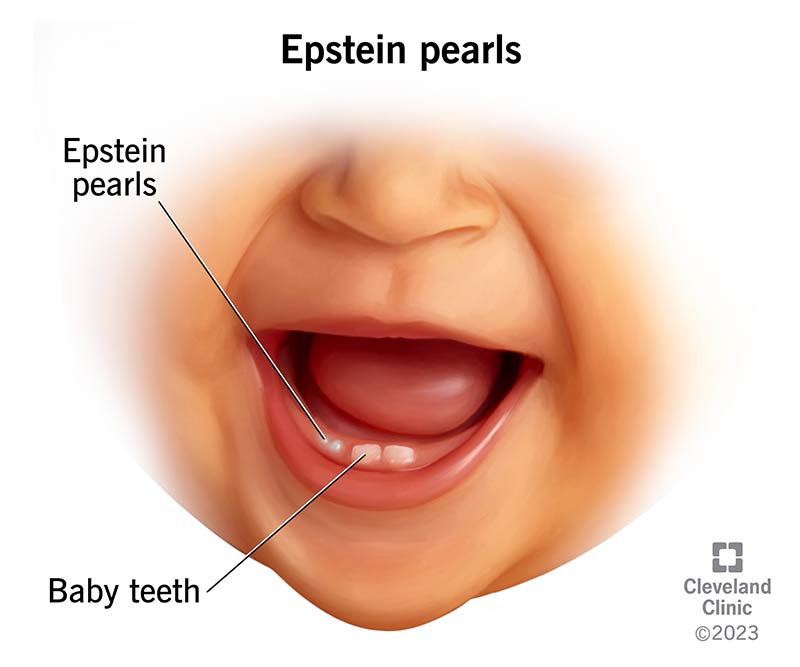Epstein pearls are small, harmless white or yellow nodules that may appear along your newborn baby’s gums or on the roof of their mouth. These bumps are common and usually go away within three months after birth.
Advertisement
Cleveland Clinic is a non-profit academic medical center. Advertising on our site helps support our mission. We do not endorse non-Cleveland Clinic products or services. Policy

Epstein pearls are small, white or yellow nodules (bumps) that may appear inside your baby’s mouth, either along their gums or in the center of their palate (roof of the mouth). In appearance, Epstein pearls resemble unerupted baby teeth. But these bumps are actually benign (noncancerous) cysts made of excess keratin (a protein that helps form hair, skin and nails). They get their name from Dr. Alois Epstein, the Czech pediatrician who first described this condition.
Advertisement
Cleveland Clinic is a non-profit academic medical center. Advertising on our site helps support our mission. We do not endorse non-Cleveland Clinic products or services. Policy
They’re common, affecting up to 85% of newborn babies. These harmless nodules usually go away on their own within three months.
Epstein pearls have no other symptoms besides their appearance. They look like white bumps underneath your baby’s oral mucosa (the skin that lines their mouth). Epstein pearls are usually small — about 1 to 3 millimeters (mm) in diameter — and quite hard to the touch. This is one reason many parents mistake them for baby teeth. They can also appear as a single nodule or in groups of them.
No, Epstein pearls shouldn’t hurt your baby or cause any issues with teething or feeding. But if it seems like your baby is in pain, take them to a healthcare provider for an examination.
Epstein pearls contain keratin buildup. Experts believe Epstein pearls form when oral tissues become trapped during fetal development. As the fetus’s mouth continues to grow, and the roof of the mouth fuses, these trapped tissues fill with keratin.
In most cases, healthcare providers can diagnose Epstein pearls just by looking at them. Depending on your newborn’s symptoms, your provider may also do an oral exam to rule out other conditions like thrush (a common fungal infection) or natal teeth (when a baby is born with teeth).
Advertisement
Epstein pearls don’t require treatment. They typically go away on their own within three months. Things like pacifiers, bottles and breastfeeding cause friction that naturally helps dissolve these nodules.
If your baby still has bumps inside their mouth after three months — or if the bumps grow larger — schedule an appointment with your pediatrician. They’ll do an exam to make sure the bumps aren’t a result of another condition.
In most cases, Epstein pearls dissolve within one to two weeks after birth. But they can last longer — sometimes for several months. Eventually, Epstein pearls should go away on their own. Though these bumps may be alarming, they’re nothing to worry about.
No, there’s nothing you can do to prevent Epstein pearls or lower your baby’s risk of getting them. These bumps are very common and are a normal occurrence in many newborn babies. If your baby has Epstein pearls, it doesn’t mean you did anything wrong — and it doesn’t mean your baby needs treatment.
Call your baby’s pediatrician if:
These things could mean something else caused the bumps. Your pediatrician can do an exam to rule out other conditions and determine whether your baby needs treatment.
“Newborn gingival cysts” is an umbrella term that describes three distinct conditions. All these conditions refer to cysts that contain keratin. These cysts look so similar that many healthcare providers use the terms interchangeably. Location is the only thing that sets them apart.
The three types of newborn gingival cysts include:
No, you should never try to squeeze or pop Epstein pearls. Doing so will only make your baby’s gums more tender and uncomfortable. Most importantly, bursting Epstein pearls can introduce harmful bacteria into your baby’s bloodstream. The best thing to do is leave them alone. They should go away on their own in time.
Advertisement
No, adults don’t get Epstein pearls. But it’s possible to develop other types of bumps along your gum line. Any time you notice a new bump inside your mouth, let your healthcare provider know.
Seeing bumps in your newborn’s mouth can be scary. But if your baby has Epstein pearls, it doesn’t mean you’ve done something wrong. These small, whitish bumps form when tissues become trapped during fetal development. They’re common in babies, and they’ll eventually go away on their own. If you have concerns about your baby’s health, or if it seems like your baby is in pain, schedule an appointment with your pediatrician. They can give your baby a proper diagnosis and determine whether they need treatment.
Advertisement
As your child grows, you need healthcare providers by your side to guide you through each step. Cleveland Clinic Children’s is there with care you can trust.

Last reviewed on 01/18/2024.
Learn more about the Health Library and our editorial process.